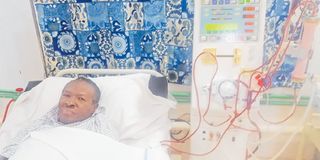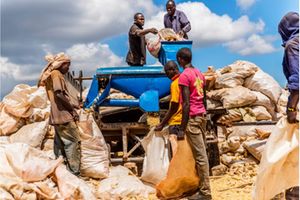It’s something I wouldn’t wish even my worst adversary, says retired doctor

LEADERSHIPFORUMDr Martin Sebalua undergoing dialysis at a private hospital in Dar es Salaam. PHOTO | TASNEEM HASSANALI
What you need to know:
The nurse from across the hall informs that the room is finally ready. With seven other patients, the elderly man is assisted by his helper to get ready for his routinely treatment.
Dar es Salaam. It was 7am. An elderly man sits slumped on the metal benches, eyes closed, outside the doors of a dialysis room.
The nurse from across the hall informs that the room is finally ready. With seven other patients, the elderly man is assisted by his helper to get ready for his routinely treatment.
“It’s not as bad as it looks,” says the 67-year-old retired doctor, Martin Sebalua. “But it’s something I wouldn’t wish even my worst enemy,” he adds.
Dr Sebalua, reclining on his bed, looked comfortable, but the tubes connecting to his dialysis machine were not readily noticeable.
As he lifts his white bed sheet, narrow transparent straw-looking tubes are connected to a dialysis machine that sits on his left carrying blood in and out of his body. This looked painful, uncomfortable and pricking.
Dr Sebalua is a diabetes patient for 22 years now. He was diagnosed with end-stage chronic renal disease causing both his kidneys to fail in 2015.
He is among 422 million people in the world living with diabetes, a non-communicable disease claiming at least 1.6 million lives per year, as stated by the World Health Organisation.
“Nobody likes to spend time in the hospital, at least not three times a week,” he says. “But you have to come for this treatment because your life depends on it.”
For three years now, Dr Sebalua comes for his dialysis sessions three times a week on Tuesdays, Thursdays and Saturdays and spends at least four hours on the bed for the session to complete.
“Dialysis might have given me mobility and hope but I know deep inside my body has given up as there is no cure for this disease (diabetes) – it’s not easy to live a life dependent on the machine,” he says sympathetically. Dr Sebalua explains that dialysis is a draining process. “You see this machine works like an artificial kidney. I’ve reached a point where I have zero output of urine and by-products. So the dialysis machine removes blood from the body where toxins and excess fluids are removed, then returns the filtered, clean blood back into the body,” he explains.
It works like a rollercoaster where the treatment performs round-the-clock kidney function in those three sessions per week.
Diabetes turned a doctor into a patient
Dr Sebalua was everything one might imagine a doctor would be in his 40s. He was at his peak in his career, confident and doing very well as a medical officer in charge at the Lushoto District Hospital, Tanga.
Yet, 22 years ago, his life took a complete U-turn when he was diagnosed with diabetes.
He had struggled with constant sluggishness, frequent urges to urinate, muscle pains and episodes of repeated thirst. These were the symptoms.
Though Dr Sebalua cannot exactly pinpoint one cause, he knew his daily routine was not healthy.
“The reason I fell victim to diabetes was completely behavioural, it had nothing to do with my family history,” he confesses, “My alcohol intake was excessive, I liked drinking beer, my diet of course was unhealthy, no physical exercise, the work was demanding and exposed me to a lot stress and yes, I was probably obese for my age at that time.”
He remembers thinking, “Here I’m running a hospital, telling people how to lead a healthy life and be cautious while the irony was that I was unhealthy, exhausted and ill.”
There was not one but perhaps many factors that led Dr Sebalua to develop diabetes, which also led to further deadly complications.
By this time, he was married and had four children. His family and colleagues suggested he takes precaution and that is when he began routinely exercising and taking measurements in what he eats.
“When you have to suddenly change the way you eat and live after 40 years of your life, it is difficult – almost depressing. It feels as if you are isolated from your closed ones – you have separate meals cooked and a different way of life. I had to completely cut down carbohydrates, refined sugar, fats and instead opted for unpolished cereals and food,” he tells.
In 2013, his life took a U-turn
Seventeen years after being diagnosed with type 2 diabetes, Dr Sebalua’s kidneys began to fail – one of the most common complications of diabetes here in Tanzania.
“I saw myself puff and swell. And I knew that there was something wrong.” Chronic kidney disease is a major determinant of poor health outcome of major non-communicable diseases. “I went under depression, it hit me hard,” Dr Sebalua tells, “all these years, I was taking care of myself with full of good intentions from losing weight to a healthy diet, but they all fell by the wayside.”
Diabetes has no cure. When Dr Sebalua came to Dar es Salaam for further check-up and consultation, a nephrologist told him that he had chronic renal failure-stage 5, which is basically the end stage. That year, Dr Sebalua retired as a doctor.
“I was told to find a donor for a kidney transplant,” that was the solution sought. “Fortunately, back then the Ministry of Health had affiliations with hospitals in India whereby they could sponsor patients like myself for kidney transplants but that doesn’t happen anymore,” he says, echoing the voices of many patients in Tanzania who are living with end stage renal disease but cannot seek possibly the best treatment for a kidney failure, a transplant. This is due to its cost related to it.
One of the other reason that patients with a kidney failure, especially the low-income patients don’t know about transplants is because their doctors do not communicate to them that it’s an option hence making them vulnerable to dialysis for a long period of time and making them less viable as transplant candidates.
“My second-born, her name’s Martha told me after learning about the possible treatment for the failed kidneys. She said and I still remember, I don’t care father if I have to live with one kidney all my life – I want to make sure you recover from this and that you are okay. And so she agreed to donate one of her two kidneys to me,” he tells. So why is Dr Sebalua still under-going dialysis while he was sponsored by the government through public hospital referral to go to India for a transplant?
“In Dar es Salaam, doctors missed a very important diagnosis that was revealed by tests and scans in India,” Dr Sebalua tells, “I had a blockage in my heart, another diabetes complication.”
Dr Sebalua spent seven months in India, spending over Sh47 million recovering from the heart surgery to repair and unblock the blood vessel in the heart that made him too weak and vulnerable for the kidney transplant. He was told to go back to Tanzania to recover and rest.
“It’s too late for a transplant now, I’m aged and I don’t want to put my daughter’s life at risk anymore,” Dr Sebalua says he has given up.
The challenge he faced after
In 2015, circumstances made him to move cities for the dialysis services. Not a single hospital or health centre in Tanga, where him and his family used to reside have a dialysis machine – forcing many families like his to either opt to move to big cities or lose hope.
“Coming to Dar es Salaam was an expensive move, not only because of the change in standard of life but we had to start all over again, bearing in mind also that dialysis sessions came with its own different expense,” he says.
Each dialysis session costs about Sh350,000 to Sh450,000 – where patients end up spending almost Sh4.2 million to Sh5.4 million per month. “I don’t think I would have been able to afford this service if it weren’t for the insurance cover, but I’m confident that an information gap still exists among the low-income families on the benefits of insurance and treatment options,” he says, reverberating concerns of those with a similar condition like his.
“In my career span, I have witnessed the magnitude of NCDs rising, it is an epidemic, especially diabetes. And the focus should definitely be on improving how we live our lives by eating right, regular screenings and exercising daily but I also urge the government on two things.
First, all regional hospitals in the country should have dialysis machines to avoid over-crowding and forced migration and second; talk to people to bridge the information gap on NCDs, available treatment and prevention,” Dr Sebalua pleads.
As the nurses and doctor came to check on how Dr Sebalua, still on his dialysis bed, was doing, he says; “They are my lifeline, they take care of me. It pricks me a little, but again look, it’s not so bad.”
Dr Sebalua is currently getting dialysis services in a private hospital in Dar es Salaam through the National Health Insurance Fund where each session costs him Sh365,000, and represents the many patients whose life has taken a toll because of preventable and modifiable lifestyle factors.



